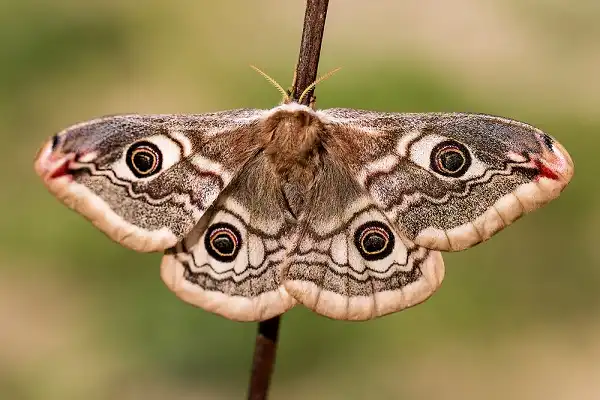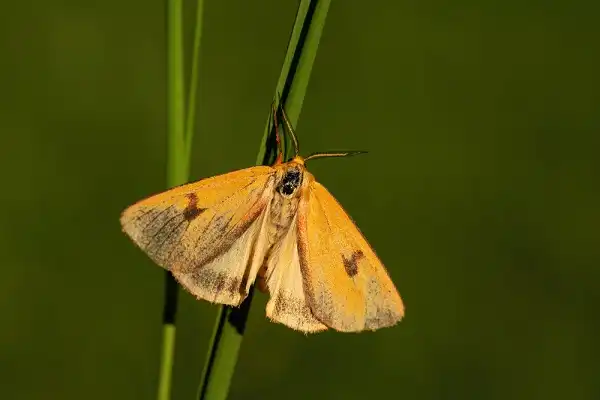Do you ever find yourself stopping to admire the beautiful details of small things? If so, then moths are an excellent subject for contemplation and appreciation. Notoriously underappreciated, these often overlooked creatures share many similarities with their butterfly brethren but still possess a unique allure that can captivate any who take the time to pause and observe them. From their large range of sizes to vibrant colors, patterns, and wing shapes, there’s a lot more to learn about moths than what meets the eye! In this blog post, we’ll explore some amazing moth facts and delve into why they have such beauty that deserves recognition.

Moth Description
Moths are a diverse species of lepidopteran insects, closely related to butterflies. They have elongated bodies with two pairs of wings, covered in scales or hairs that provide them with protection. The coloration of moths can vary greatly, from the dull grey hues of some nocturnal moths to the bright colors and intricate patterns of diurnal species. Many moths also possess eye-catching spots, stripes, or bands along their wings and bodies. Additionally, their vibrant coloration and intricate patterns are often just as varied as their overall shape; although some nocturnal moths may be dull grey in color, many diurnal species exhibit brighter hues that are accompanied by unique spots, stripes, or bands along their wings and abdomens. Moths often fly at night and rely on their large eyespots to startle predators when they are disturbed. These eyespots may be located anywhere on the moth’s body and come in various shapes and sizes depending on the species. Some moths even use bright colors to warn birds away by appearing unappetizing.
Moth Habitat
Moths are found in a wide variety of habitats around the world, from forests and grasslands to deserts and wetlands. While many species of moths can survive in urban environments, they usually prefer natural areas with plenty of flowers and foliage for food sources. Moths are generally nocturnal insects, however, some species, such as the Hummingbird Moth, are active during the day. Moth habitats typically provide them with food sources such as nectar-rich flowers and leaves from trees or shrubs. They also need shelter during the colder months of the year in order to hibernate or enter diapause until springtime.
For this reason, moths will often seek out sheltered areas like caves and hollow tree trunks or build cocoons inside leaf litter or bark crevices for protection against harsh weather conditions. The sheer diversity of moths makes them an integral part of any ecosystem they inhabit; from aiding pollination processes to serving as prey for birds and other predators – it is clear that moths play an important role within their respective habitats. By learning more about their behavior and ecology we can better understand how important it is to conserve moth habitats in order to ensure healthy populations worldwide!
Moth Diet
Moths have a variety of diets that are adapted to the specific needs of their species. Many moths feed on nectar or plant sap, with some species having specialized mouth parts for accessing this food source. Other moths prefer insect prey such as caterpillars and flies, while some only eat pollen. Some moth larvae may also feed on decaying organic matter like leaf litter or dung. Nocturnal species of moths tend to be more focused on nectar feeding during the night, while diurnal species rely more heavily on other sources of food during the day. Nectar provides adult moths with energy and sugars for flight, while pollen is an important source of protein that is necessary for reproduction and growth in larvae. Furthermore, some species rely heavily on certain plants as host plants which provide essential nutrients for their egg-laying and larval development stages.

Moth Size
Moth size varies greatly among species, from the tiny pygmy moth which can measure less than 1 cm in length to the massive Atlas moth whose wingspan can reach up to 25 cm in size. This incredible size range is due to evolutionary adaptations that have allowed moths to occupy a variety of niche habitats throughout the world. Moths also come in a large spectrum of shapes and sizes. Some species display elongated bodies with scalloped wing edges or pointed tips, while others possess more rounded wings and bodies. The large eyespots commonly found on many moths not only provide them with an impressive appearance but also serve an important purpose; these spots allow moths to startle predators when they feel threatened, helping them to survive in hostile environments.
Moth Lifespan
Moth lifespan can vary greatly depending on the species. Many moths have a very short adult lifespan, lasting anywhere from a few days to a couple of weeks. During this time, they must quickly reproduce and lay their eggs in order to ensure the survival of their species. Other moths have longer lifespans of several months or even years due to their ability to enter into a hibernation-like state known as diapause. This allows them to survive harsh winter conditions and emerge in the springtime when food sources are more plentiful. The pupal stage of some species may also last for extended periods before the adult form emerges. The average lifespan of moths is highly dependent on environmental factors such as temperature, humidity, food availability, and predation levels. As such, some moth species may live much longer or shorter lives depending on where they reside and the local climate conditions they experience each year. Additionally, some species may be capable of living longer if provided with additional resources like nectar supplements or host plants for egg-laying purposes.
Moth Behavior
Moth behavior is highly diverse and depends on the species in question. Most moths are nocturnal, meaning they are most active at night when the air is still and temperatures are cooler. During this time, moths fly around in search of mates or food, navigating using their antennae to sense their surroundings. Additionally, some moth species may use a combination of chemical and visual signals to locate potential mates during reproduction. When it comes to defending themselves from predators, many moths will rely on camouflage to blend into their environment or display bright colors as warning signs. Some species also employ physical defensive tactics such as producing squeaking noises that can startle potential predators or releasing foul-smelling compounds from specialized glands located on their bodies.

Moth Speed
Moth speed can vary greatly among species, but on average, they tend to fly anywhere from 15 to 25 mph. This relatively fast flight speed allows them to quickly search for food sources or mates in a short amount of time. One interesting fact is that moths have the ability to change their flight speed depending on the environment – flying more slowly when navigating through dense vegetation or speeding up while flying over open spaces. Moth speed also depends on the time of day. During the day, moths are generally slower and less active as they rely more heavily on thermals and sunlight to stay airborne.
y while hunting for food or seeking out potential mates. In addition to their average flight speed, some moths possess other adaptations that increase their mobility and agility. For example, many species of hawk moths possess a specialized proboscis attachment that allows them to hover in mid-air while feeding on nectar from flowers – making them incredibly adept at quickly gathering food resources. Furthermore, some moth species have evolved modified wings that enable them to fly in rapid bursts of speed that can reach up to 60 mph!
Moth Species
Moth species come in a wide variety of shapes, sizes, colors, and patterns, with over 160,000 species worldwide. The common clothes moth (Tineola bisselliella) is one of the most widespread and can be found in both warm and cool climates. These moths are small in size with wingspans of around 1/2 inch and have distinctive buff to golden-colored wings. Other notable moth species include the Luna Moth (Actias luna), one of the largest moths in North America with a wingspan that can reach up to 5 inches across. This species is easily recognizable due to their bright green bodies and long tails on their hindwings. Other large moths include the Atlas Moth (Attacus atlas) which has some of the longest wingspans in its class at between 8-10 inches.
Additionally, many nocturnal moth species have evolved bold eyespots or false eyes on their wings for protection from predators. Examples of these include the Hummingbird Hawk-moth (Macroglossum stellatarum) which has mesmerizingly large eyespots that resemble those of hummingbirds when it is at rest. Other unique moth species include the Emperor Gum Moth (Opodiphthera eucalypti) which has color-changing patterns on its wings depending on its age as well as other species like Elephant Hawk-moths (Deilephila elpenor) which mimic the look of elephant trunks when they are resting.
Moth Hunting
Moth hunting is an activity that involves searching for and collecting different species of moths. It is a popular hobby among naturalists and insect enthusiasts alike due to the vast array of moth species available to hunt and observe. Moth hunters must often be patient and observant, as some moth species can be quite clever when it comes to hiding away during the day. To catch moths, hunters typically use a combination of light sources, such as UV lamps or black lights, in order to attract moths to their area. Alternatively, they may also use bait like fermented fruit or sugar water in order to attract their desired species. Once the moths have gathered around the light source, hunters can then collect them using either a net or gentle hands.

Conclusion
Moths are one of the most fascinating and diverse creatures in nature, with over 160,000 species worldwide. They boast a wide variety of shapes, sizes, colors, and patterns – making them incredibly interesting to observe. Additionally, moths play an important role within any ecosystem they inhabit due to their unique behaviors such as nectar feeding and pollen collecting which aids in pollination of nearby plants. Moreover, moth speed is quite impressive – allowing them to quickly maneuver through their environment while hunting for food or mates. Furthermore, there are many ways to appreciate the beauty of moths including simple observation or more scientific pursuits like recording data on different species found in an area for conservation reasons.
Frequently Asked Question


